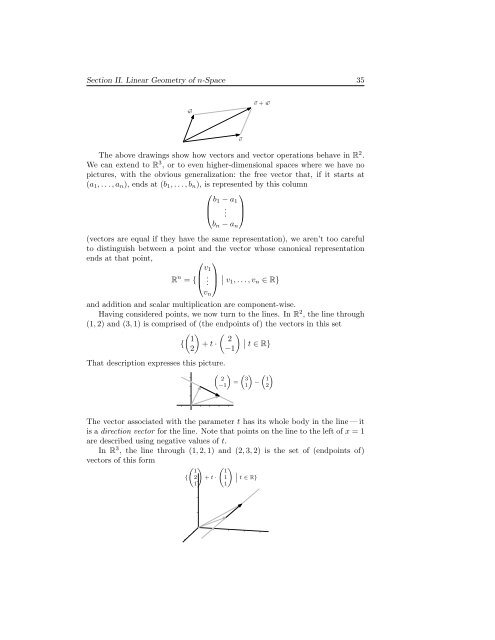Linear Algebra - Free Books
Linear Algebra - Free Books
Linear Algebra - Free Books
Create successful ePaper yourself
Turn your PDF publications into a flip-book with our unique Google optimized e-Paper software.
Section II. <strong>Linear</strong> Geometry of n-Space 35⃗w⃗v + ⃗wThe above drawings show how vectors and vector operations behave in R 2 .We can extend to R 3 , or to even higher-dimensional spaces where we have nopictures, with the obvious generalization: the free vector that, if it starts at(a 1 , . . . , a n ), ends at (b 1 , . . . , b n ), is represented by this column⎛ ⎞b 1 − a 1⎜ ⎟⎝ . ⎠b n − a n(vectors are equal if they have the same representation), we aren’t too carefulto distinguish between a point and the vector whose canonical representationends at that point,⎛⎞v 1R n ⎜= { .⎝ .v n⃗v⎟⎠ ∣ ∣ v 1 , . . . , v n ∈ R}and addition and scalar multiplication are component-wise.Having considered points, we now turn to the lines. In R 2 , the line through(1, 2) and (3, 1) is comprised of (the endpoints of) the vectors in this set( ( ) 1 2 ∣∣{ + t · t ∈ R}2)−1That description expresses this picture.(2−1)=(31)−(12)The vector associated with the parameter t has its whole body in the line — itis a direction vector for the line. Note that points on the line to the left of x = 1are described using negative values of t.In R 3 , the line through (1, 2, 1) and (2, 3, 2) is the set of (endpoints of)vectors of this form) ) ∣∣t ∈ R}{( 121+ t ·( 111
















